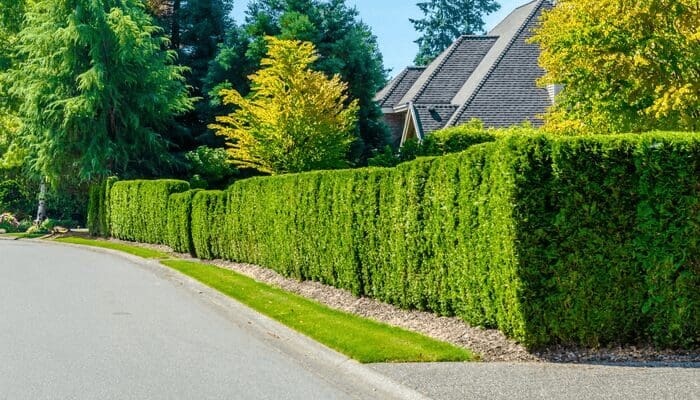How to Landscape Your Front Yard on a Busy Street: 7 Ideas to Sell Faster
- Published on
- 5 min read
-
 Christine Bartsch Contributing AuthorClose
Christine Bartsch Contributing AuthorClose Christine Bartsch Contributing Author
Christine Bartsch Contributing AuthorFormer art and design instructor Christine Bartsch holds an MFA in creative writing from Spalding University. Launching her writing career in 2007, Christine has crafted interior design content for companies including USA Today and Houzz.
Selling a house on a busy street? Unfortunately you can’t pick up your house and move it. But with a little strategic landscaping, you can mitigate the noise factor and increase the marketability of your home to potential buyers with amazing curb appeal.
Depending on your home’s positioning, a sturdy container garden and low fence barrier could be all you need to help sell your home. For extreme cases, you may need to call in the pros for some official noise-reduction landscaping.
Get familiar with your wide range of options here—we’ll cover the gamut with these 7 ideas ranging from simple plantings to practically setting up the Great Wall of China on your lawn. (We kid, but this stuff can be serious!)
 1. Make sure your house remains visible and beautiful from the street
1. Make sure your house remains visible and beautiful from the street
The more greenery you have around your house the better, because plants are known noise reducers and mature trees in a well-landscaped yard can increase your home value by 7% to 19%. However, when you landscape to block traffic and noise, don’t do so to the point that you obscure the view of the house from the street.
“Buyers need to see the house because they use curb appeal to give a quick yes or quick no on a property,” advises Tim Keady of the top performing Tim and Darcy Keady father/daughter real estate team based in Denver, Colorado. “If they can’t see the house, it’s always a quick ‘no.’”
In fact, living on a busy road translates to a ton of free advertising for your house. Imagine every person who passes by as a potential buyer, and add a few eye-catching colors to your flower beds, window boxes, and planters.
2. Go with cost-effective, container garden landscaping
Let’s say you don’t have any (or enough) established bushes and trees and would like to add some landscaping before you put your home on the market. Rather than plant anything permanent, you can imitate the size and height of various plants (which help pad noise and add visual interest) by planting new foliage in containers.
A few evergreen conifers or Japanese maples in sturdy containers add a temporary barrier without you having to spend money on landscaping that you can’t take with you when you move.
Pro tip: Play around with your arrangement before actually planting your foliage in the pots. Containers filled with soil and plants get mighty heavy, making them much harder to move—and you may even do damage to your lawn dragging them around.

3. Use artificial turf to revive your damaged lawn
Busy streets aren’t just overwhelmed with heavy vehicle traffic, many have their share of excessive foot traffic, too, which can be murder on a front lawn.
Whether it’s pups doing their business or neighbors who cut across your yard—sometimes it’s just tricky to keep grass alive. If you don’t have time to regrow your tattered front lawn before listing your house, it might be wise to install a synthetic lawn.
“We had one listing this year that was a rental house, and they had fake grass because it’s in a nice neighborhood where you’re expected to have pretty grass,” recalls Tim Keady.
“It was Fall, and with the leaves falling on it, you couldn’t even tell the grass was fake.”
Fake grass may be an attractive solution to a dead front lawn, but it’s not a cheap one. Artificial turf installation costs anywhere from $1,250 to $6,250 depending on the size of your yard, and the quality of the turf you select.
Spend that amount of money on a house you’re selling may just be worth it. Fake grass is a major expense up front, however after installation the grass is maintenance free for 15 to 25 years. While you won’t be around to reap that benefit, buyers may pay more for a yard they won’t have to pay to water or trim.
4. Install a front yard fence to create a visual barrier
If your yard backs up to a busy road, your best options for a fence that blocks noise are either a thick masonry wall or, if you care more about looks, a thick, tall, and gapless wooden fence.
As far as your front yard goes, ideally you should still be able to see the house from the road, limiting your ability to construct a higher fence barrier.
A low barrier between your house and the busy street, though it won’t create an impervious sound blocker, at least adds a sense of privacy and discourages lawn traffic. Better yet if the fence connects to the house as a way to contain young children or pets.
“We’ve seen shorter ones on the cute little houses downtown that have a little gate across the pathway to the front door,” remarks Darcy Keady. “This is a great idea to deter loiterers, which can be a problem on some busy streets.”
In most areas, three feet is the standard height for front yard fences and common material selections include picket, brick, wrought iron, split rail, stone, and stucco. (Check with your homeowners association or consult a legal professional before installing your front yard fence, as you may need to obey local laws and follow regulations when selecting your fence height and style.)
Fencing typically runs between $13 to $50 per linear foot, and how much the project will cost you depends on the size of your front yard and the type of fencing you select.
At $8 to $16 per foot, wood fencing options like split rail or picket are typically less expensive than brick or stone—but they’re also less substantial.
Finally, plant hedges along your fencing to boost the sense of separation from the busy street and help with the noise. Just make sure to plant inside of your fencing, not outside, so your hedges don’t become a dumping ground for litter.

5. Consider the courtyard option
On especially busy streets where traffic noise and trespassers are a major problem, short fences won’t help much. If that’s the case with your house, then a tall fence may be an option to salvage the usefulness in your front yard—by creating a courtyard.
“Courtyards are terrific if they’re common to the area. And if the house is totally obscured, you can install a brochure box outside for flyers that include photos that show what the courtyard looks like,” says Tim Keady.
A courtyard will block out the busy street problem. Plus, it creates an additional outdoor living space that can become a selling point—if your courtyard is properly designed and staged. Picture a flagstone patio, comfy, cushioned seating, and maybe a small fire pit.
Front yard courtyards are de rigueur in some cities and neighborhoods, especially on townhomes and row houses with little to no backyards. If that’s not the case in your area, then creating a courtyard out front is a risky move that could hurt your home sale.
“If you add a courtyard to the front of a house in a neighborhood where there’s not a lot of courtyards, then it’s got to be marketed correctly,” advises Tim Keady. “Buyers need to understand that the courtyard you’ve added is usable and offers more privacy.”
6. Mask distracting street noise with a water feature
If unpleasant street sounds are your biggest problem, then the delightful warbles of a water feature may just be the answer.
“A small water feature near the entryway is a good idea,” says Darcy Keady. “It helps mask the street noise while potential buyers are waiting for their agent to open the lockbox.”
From ponds and waterfalls to reflecting pools to fountains, your water feature options can get expansive. Installing a large, permanent water feature costs between $1,228 to $2,710, depending on the type, size, and complexity of the project.
However, when your main purpose for adding one is to help sell your house, it’s best to steer clear of these expensive, permanently installed water features.
“I’m all for portable water features,” adds Tim Keady. “Permanent water features are expensive and they won’t please everybody. Some buyers will love it, while others won’t like having a water feature that they need to maintain.”
There are plenty of outdoor fountain options that require nothing more than an outlet to plug in the pump and fresh water every few days. Easy-install, moveable fountains are a lot less expensive, too. You can find options to complement any exterior home style for as little as $100 to $300 or less.

7. Invest in professional, noise-reducing landscaping
Improving your curb appeal to reduce the negative impact of your busy street location is definitely doable as a DIY project. However, reducing intrusive noise levels isn’t quite as easy without a little expert help.
When all your efforts to diminish street noise fail, then it’s time to bring in a landscaper with experience in noise reduction landscaping. (Yes, it’s actually a thing!)
Noise reduction landscaping is an outdoor design strategy that incorporates multiple sound-dampening elements.
“We just sold a home on a busy street with a large, stacked brick wall that leveled out the front yard and was also effective as a noise reflector,” recalls Tim Keady. “That house also had several large fir trees in one corner of the lot, which are effective in absorbing some of that street noise year-round.”
The typical noise reduction landscaping plan includes a variety of plants and rough bark trees to absorb sound, plus fencing selected for its ability to deflect or reflect sound. It may even include pathway surfaces and/or climbing vines to refract or dissipate sounds, along with a white noise element like a water feature selected for its loud splashes.
Landscaping for busy roads: Is there a simpler solution?
As you set out to sell your house on a high-traffic road, know that no perfect combination of large trees and well-placed shrubs will 100% block out the rush of cars going by or eliminate the hassle of pulling in and out of the driveway.
“It does bring down the value a little when a home is located on a busy street, so you need to price accordingly,” says Darcy Keady. “If you do price it to market and the showing activity is strong, but the offer activity is weak, you may need to make a price reduction,” adds Tim.
Before you invest in a bunch of 12 to 15-foot maples which could cost a couple grand each, talk to a top local agent about whether a price adjustment would be easier to execute than a landscaping overhaul—or find a way to meet somewhere in the middle.
Header Image Source: (Maximillian Conacher/ Unsplash)
